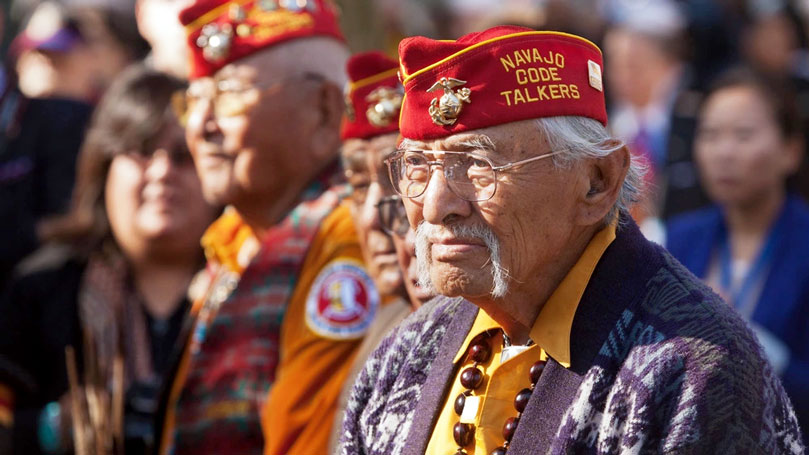
President Trump is on the rampage against many things, including the issue of language. On March 1, he issued an executive order declaring English to be the official language in the United States. This has never been declared before, though some states already are so designated.
In Trump’s campaign against DEI, government agencies are stripping their archives of any mention of the contribution of people of color to our country. This is happening in the armed forces, too. So it does not come as a great surprise that the army archive websites have been stripped of information and images related to the Navajo Code Talkers.
Native American languages were used as codes for military communications in both the First and Second World Wars. The Navajo language, which the Navajos themselves call “Diné Bizaad,” was a major resource in the Pacific theater in the Second World War, but from time to time Comanche, Mesquakie, Muskogee, and other languages of the original inhabitants of this country were also used. This was facilitated by the fact that Native American young men had a very high rate of participation in the U.S. armed forces’ ranks.
Pre-Trump, the now elderly code talkers were honored as national heroes for their contributions. So were the Tuskegee Airmen and others like them. But this, too, is now being stigmatized as “DEI” propaganda. Anything that highlights the contributions of minorities or women is now labeled “DEI,” the insult of choice for the MAGA crowd. The racism could not be more blatant.
What is the real story of language use in this country? Of course, when the first European settlers arrived in what is now the United States, the people they found here were speaking hundreds and hundreds of different languages. The earlier English speaking colonists did not think it was worth their while to learn the Indigenous languages, but the power relationships established by European colonial expansion put pressure on the Indigenous communities to learn English, Spanish, and French. Over the courses of the 17th, 18th, and 19th centuries, the number of speakers of Indigenous languages was reduced by various processes, including war, massacres, introduced diseases, and Christian conversions. In the 19th and 20th centuries, the horrific system of “Indian schools” played a truly genocidal role. Native American children were taken from their families and ethnic communities, often by force and without the agreement of their parents (“parents’ rights,” eh?), and subjected to a regime of abuse intended to strip them of their original languages and cultures, heavily traumatizing and sometimes killing them in the process. The slogan of this system of schools was “kill the Indian, save the man.”
Many years ago, I had a conversation with an elderly Cherokee woman who had attended one of these schools. She told me that if teachers or staff heard her using one word of the Cherokee language, she would be forced to sit for hours in the corner with her nose pressed against the wall. This is how “Indians” were supposed to be “saved.” As she recounted this to me, she began to cry.
Now today, somewhere between four hundred thousand and half a million people in the United States continue to speak one or another of about one hundred surviving Indigenous North American languages. For many of those languages, the only Native speakers are quite elderly, but there are exceptions, and there is push back in the form of language revitalization projects. Approximately 178,000 people of all ages speak Diné Bizaad, the Navajo tongue, and this number is increasing. Other languages with considerable numbers of Native speakers are Western Apache, O’odam, Choctaw, Muskogie, Lakota/Dakota, Zuñi, Hopi, Tewa, Keresan, Yupik Inuit, and others. And in quite a few communities, there are lively and well appreciated revitalization programs in which, for example, young people who did not learn their community’s original language from their parents are learning it via adult and childhood education programs.
Some of these programs rely on money from federal sources. This is true also of bilingual and multilingual education projects, which serve Spanish speaking communities and others, and from which millions of children benefit greatly. Spanish was, by the way, spoken in what is now the United States long before English. But, say the MAGA people, English is the language of this country, period.
What is going to be the policy of the Trump administration toward language, given the racist rhetoric we are already hearing? We shall see, but prospects do not look good. Trump has a history of anti-Indigenous bigotry going way back, and one of his earliest executive orders this year revoked a Biden order mandating more cooperation between the federal government and Native communities. Trump people have cast doubt on the actual U.S. citizenship of Indigenous people, and there are complaints about ICE harassing Native American people, including from the Navajo Nation.
What should be our own response to all these things happening now and yet to come? That is an easier question to answer: Solidarity against every racist attack. And the attacks on DEI and language minorities are racist attacks, no doubt about it.
The opinions of the author do not necessarily reflect the positions of the CPUSA.
Image: A Navajo code talker veteran watches the opening ceremony for the 93rd Anniversary of The New York City Veterans Day Parade by CWO2 Bryan Nygaard (DVIDS / public domain)


 Join Now
Join Now